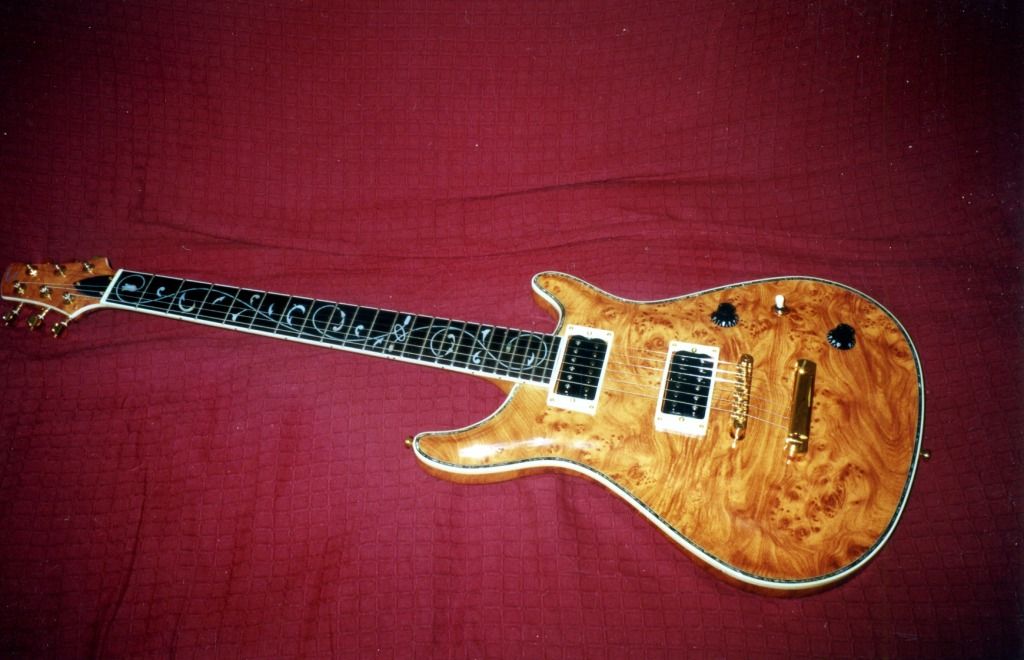I am well and truly in love with this guitar, not only for how it sounds; but how it plays with a neck and fretboard that are way over their price in quality and playability. Its whiteness was beginning to bug me in the sense that it was almost cold and that beneath all that paint there was another guitar waiting to be released from its jacket of polyester finish.
Common sense also told me that I had no way of knowing what was under the paint and how many pieces of wood I would find on the back or indeed the front of the guitar. It is no secret in the guitar industry that solid painted guitars are destined for multiple pieces of wood. No complaint on that as logic dictates covering a superb grained piece of wood with a solid colour is nothing short of sacrilege. At this stage I should point out that the should I or should I not debate, was going around what I have for a brain for several weeks before I actually bit the bullet.
Once I had purchase several sheets of various grades of wet and dry sanding paper starting with 180 grit, 240 grit, 320 and finally1,000 grit my mind was made up. Off came the hard ware and with the fret board masked up I decided to start with the back of the guitar. As I held the sanding block in my hand it crossed my mind that this was the moment of truth and once I started there was no turning back.
I started in the middle which quickly confirmed this was not a two piece back and most certainly was a three piece. This was quickly confirmed as was this is not Mahogany or if it was it was not a Mahogany that I had seen on a guitar before. The poly lacquer and paint was not too difficult to remove about 2-3 hours I guess but I wasn?t prepared for the sealer underneath which took even longer to remove. No wonder the wood on the guitar couldn?t vibrate or give of its nuances as it really was cocooned in polyester.


Note on the picture above the darker area is the sealer and believe me it was a real pain to sand it off bearing in mind it was all done by hand with no power tools or paint remover.
Once fully blocked off several coats of True Oil, and in between coats flatted off with wire wool; finished the job, not too many as I did not want a highly gloss back. Just sufficient to seal the back of guitar and here it is in all its glory. A three piece quarter sawn Sapele back which to mind contradicts the Tokai catalogue which states the guitar has a Mahogany back. No big deal for me as Sapele is a little brighter than Mahogany also more dense and solid or shall we say heavier. It?s also no secret that it is about 5 X less expensive than Honduran Mahogany. Here is a link worth reading http://www.taylorguitars.com/guitars/acoustic/features/woods/body-woods/sapele

I'll post the top shortly.
Common sense also told me that I had no way of knowing what was under the paint and how many pieces of wood I would find on the back or indeed the front of the guitar. It is no secret in the guitar industry that solid painted guitars are destined for multiple pieces of wood. No complaint on that as logic dictates covering a superb grained piece of wood with a solid colour is nothing short of sacrilege. At this stage I should point out that the should I or should I not debate, was going around what I have for a brain for several weeks before I actually bit the bullet.
Once I had purchase several sheets of various grades of wet and dry sanding paper starting with 180 grit, 240 grit, 320 and finally1,000 grit my mind was made up. Off came the hard ware and with the fret board masked up I decided to start with the back of the guitar. As I held the sanding block in my hand it crossed my mind that this was the moment of truth and once I started there was no turning back.
I started in the middle which quickly confirmed this was not a two piece back and most certainly was a three piece. This was quickly confirmed as was this is not Mahogany or if it was it was not a Mahogany that I had seen on a guitar before. The poly lacquer and paint was not too difficult to remove about 2-3 hours I guess but I wasn?t prepared for the sealer underneath which took even longer to remove. No wonder the wood on the guitar couldn?t vibrate or give of its nuances as it really was cocooned in polyester.


Note on the picture above the darker area is the sealer and believe me it was a real pain to sand it off bearing in mind it was all done by hand with no power tools or paint remover.
Once fully blocked off several coats of True Oil, and in between coats flatted off with wire wool; finished the job, not too many as I did not want a highly gloss back. Just sufficient to seal the back of guitar and here it is in all its glory. A three piece quarter sawn Sapele back which to mind contradicts the Tokai catalogue which states the guitar has a Mahogany back. No big deal for me as Sapele is a little brighter than Mahogany also more dense and solid or shall we say heavier. It?s also no secret that it is about 5 X less expensive than Honduran Mahogany. Here is a link worth reading http://www.taylorguitars.com/guitars/acoustic/features/woods/body-woods/sapele

I'll post the top shortly.















